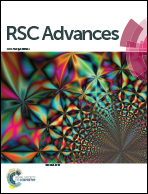Adsorption of heterocyclic sulfur and nitrogen compounds in liquid hydrocarbons on activated carbons modified by oxidation: capacity, selectivity and mechanism†
Abstract
In order to understand the adsorption mechanism for removing heterocyclic sulfur/nitrogen compounds from liquid hydrocarbons on activated carbon, the liquid-phase adsorption of quinoline, indole, benzothiophene, dibenzothiophene as well as naphthalene and fluorene on four activated carbons were conducted in both batch and fixed-bed adsorption systems by using model fuels. The four activated carbons with different surface chemistries were prepared by oxidation with ammonium persulfate (APS) and heat treatment, and their oxygen-containing functional groups (OCFGs) on the surface were characterized by the temperature-programmed desorption (TPD). The influences of surface OCFGs and co-existing compounds on the adsorptive removal of heterocyclic sulfur/nitrogen compounds were examined. The results showed that the OCFGs play a decisive role in the adsorptive removal of nitrogen compounds. For the carbon adsorbents with no OCFGs, the adsorption is conducted dominantly through the π–π stacking interaction and the affinity of adsorbates is dependent on the size of their π systems. For the carbon adsorbent with bound OCFGs, the adsorption is dominantly based on the acid–base interaction and the π–H interaction, resulting in the much higher capacity and selectivity for nitrogen compounds. The carbon adsorbent with phenol, carboxylic anhydride, and lactone groups, but no carboxylic groups gives the highest capacity and selectivity for indole, probably through the H-bond interaction. The effect of the co-existing compounds depends on their adsorption mechanism and affinity. Careful design and modification of carbon adsorbents are able to selectively remove the undesired compounds from the liquid hydrocarbons.


 Please wait while we load your content...
Please wait while we load your content...